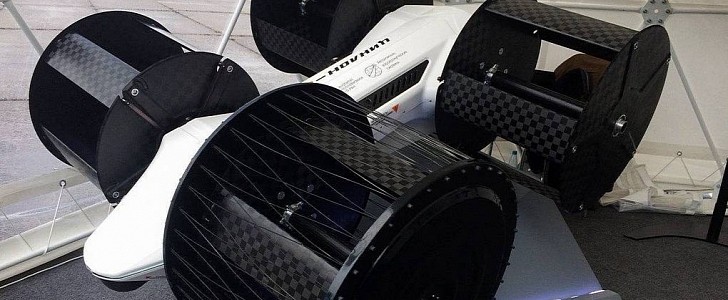Humanity has been dreaming about Jetsons-like flying cars long before the Jetsons even existed. Yet, midway into 2021, we’re still not even close to seeing that dream become a reality, at least not from a commercial perspective.
We have eVTOL proposals and eVTOL concepts, with these electric vertical take-off and landing aircraft hailed as the future of urban mobility, one where we will head to the sky to move about our ever-busier cities. With big companies focused on eVTOL development, Russia has been tinkering away at its own version of a flying car, the Cyclocar.
News of the Cyclocar was first made public in April this year, when a state-sanctioned press release noted that it was a cyclolet that would use either hybrid or electric drivetrain with a cyclic propulsion system. It can transport either gear or a 6-people payload over great distances, at considerable height and with the ability to hover in place. The same release casually noted that the first tests of the Cyclocar were already underway and that the first flights will take place in 2022.
Cyclocar is sticking to this timeline, Interesting Engineering reveals. As the video at the bottom of the page shows, a scale-model of the Cyclocar has already been flown, with researchers at the Siberian Branch of the Russian Academy of Sciences, working on the Cyclone Project, testing the cyclic propulsion system on a vehicle with a 60 kg (132 pounds) payload.
The full-scale Cyclocar model will take flight in 2022, with the makers hoping to see a 2024 production start. Based on a previously released video (also available below), the Cyclocar will first be made available for the military, which makes sense, considering we’re talking about a state-backed project in Russia.
The Cyclocar will have a range of 500 km (311 miles) and reach top speeds of 250 kph (155.3 mph). Measuring 6.2 by 6 meters (20.3 by 19.6 feet), it will have a payload of 600 kg (1,323 pounds), which would make it ideal for both official and civilian use. Thanks to its cyclical propellers, it will land on surfaces with a 30-degree incline and hover vertically for docking, offering quick access to areas not accessible by foot (think of combat scenarios). The flying car will be operated by a pilot on board or remotely controlled by a technician on the ground.
News of the Cyclocar was first made public in April this year, when a state-sanctioned press release noted that it was a cyclolet that would use either hybrid or electric drivetrain with a cyclic propulsion system. It can transport either gear or a 6-people payload over great distances, at considerable height and with the ability to hover in place. The same release casually noted that the first tests of the Cyclocar were already underway and that the first flights will take place in 2022.
Cyclocar is sticking to this timeline, Interesting Engineering reveals. As the video at the bottom of the page shows, a scale-model of the Cyclocar has already been flown, with researchers at the Siberian Branch of the Russian Academy of Sciences, working on the Cyclone Project, testing the cyclic propulsion system on a vehicle with a 60 kg (132 pounds) payload.
The full-scale Cyclocar model will take flight in 2022, with the makers hoping to see a 2024 production start. Based on a previously released video (also available below), the Cyclocar will first be made available for the military, which makes sense, considering we’re talking about a state-backed project in Russia.
The Cyclocar will have a range of 500 km (311 miles) and reach top speeds of 250 kph (155.3 mph). Measuring 6.2 by 6 meters (20.3 by 19.6 feet), it will have a payload of 600 kg (1,323 pounds), which would make it ideal for both official and civilian use. Thanks to its cyclical propellers, it will land on surfaces with a 30-degree incline and hover vertically for docking, offering quick access to areas not accessible by foot (think of combat scenarios). The flying car will be operated by a pilot on board or remotely controlled by a technician on the ground.






